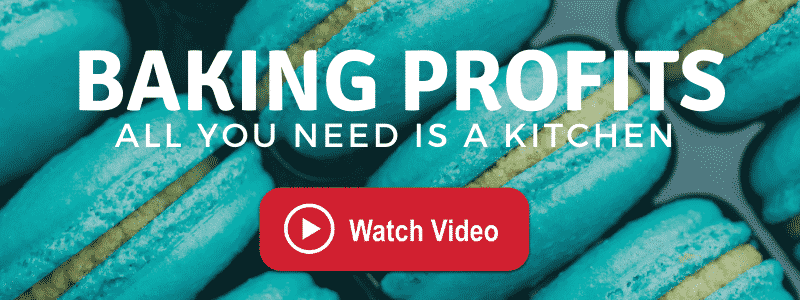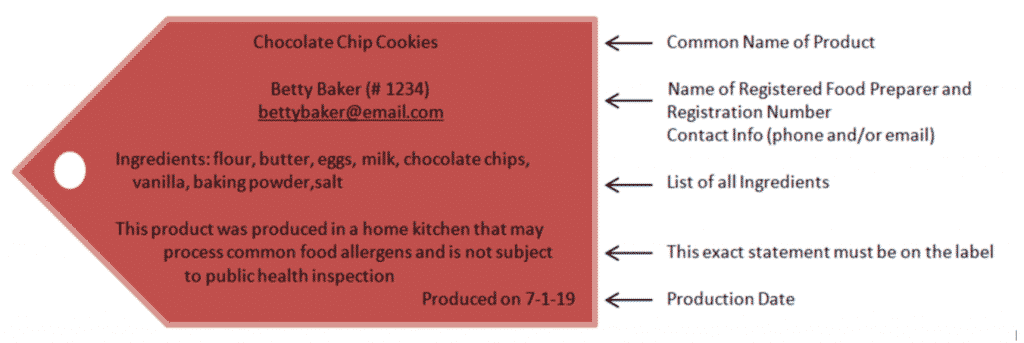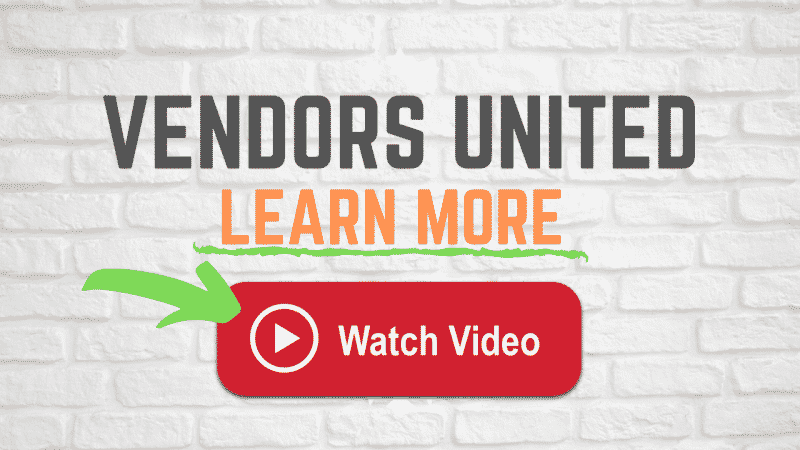Connecticut Cottage Food Laws allows individuals to make homemade products that are neither potentially hazardous nor Time or Temperature Control for Safety (TCS) Foods, and offer them for commercial sale.
Connecticut has made it easy to get started with minimal restrictions.
Table of Contents
CONNECTICUT COTTAGE FOOD LAWS – Foods That Are Allowed
The following list is comprised from the Official Connecticut Department of Health website. Some examples of potentially acceptable cottage food are:
- Loaf breads, rolls and biscuits
- Sweet breads, bakery type desert breads, muffins, cookies
- Non-potentially hazardous cakes including celebration cakes (e.g. birthday cake, but not cheese cake)
- Non-potentially hazardous pastries and cookies
- Candies and confections
- Fruit pies (not pumpkin)
- Jams, jellies and preserves (must meet the Standard of Identity in 21CFR150)
- Dried fruits
- Dry herbs, seasonings and mixtures
- Non-potentially hazardous cereals, trail mixes and granola
- Coated or uncoated nuts
- Vinegar and flavored vinegars
- Popcorn and popcorn balls
- Cotton Candy
- Roast Coffee Beans
- Frosting / Icing – Click here for Buttercream Frosting State Info
PLEASE NOTE: This list is not inclusive. Products on this list are not automatically approved, and the list above is subject to change.
See contact information below to double check your planned foods before starting.
Real Life Cottage Food Entrepreneurs and Opportunities
- Cakes – teacher turns kitchen into bakery
- Doughnuts – cottage mini donut vendor
- Fruit jams and jellies – See Additional Requirements Here
- Kettle corn – real kettle corn vendors from home
- Popcorn (plain and flavored) – see a real home vendor here
- Talk and Join hundreds of others here: VendorsUnited.com

IF YOUR COTTAGE FOOD ITEM IS NOT LISTED?
If the food you would like to offer is not listed above – you can apply to have it added here.
Department of Consumer Protection
Food and Standards Division
[email protected]
(860) 713-6160
CONNECTICUT COTTAGE FOOD LAWS – PROHIBITED FOODS
Connecticut doesn’t maintain a list on the cottage foods that are prohibited. Assume anything not on the above list as prohibited until you verify and get approval. Contact: (860) 713-6160
NOTE: Although eggs, milk and dairy products are not allowed, used as ingredients for the allowed foods – is acceptable.
Many prohibited foods that are baked or cooked into the allowed foods are rendered harmless and therefore allowed.
ACIDITY LEVELS AND TESTING
Most states determine if a food is non-potentially hazardous by the acidity level found in the food. The higher the acidity, the more stable at a range of temps, that food product is.
For example: milk is low acidity and requires temperature controls.
The acidity of foods is measured by pH.
• The range of pH is commonly considered to extend from zero to 14. A pH value of 7 is neutral because pure water has a pH value of exactly 7. Values less than 7 are considered acidic, while those greater than 7 are considered basic or alkaline.
• All fruits are acidic foods and are usually tart and sour. Ex: tomato, lemon, peach, apple, etc.
• The FDA rule for acidic foods states that a food must have a pH below 4.6 to be sold as a minimally processed food.
• The reason for this is bacteria does not grow at this level of acidity.
• The exclusion shall not be construed as allowing the sale of low acid foods (pH > 4.6) in
hermetically sealed containers (i.e. home-canned green beans, peas, etc.) when such
food is not prepared in a permitted establishment.
TESTING
Some states require testing if the pH level is unknown. For many food products, the pH level is already known.
You can test for pH yourself using a pH spear tester. (make sure it is made for food and has a long spear tip).
Oklahoma State University shares an awesome guide for selecting the correct tester for foods and liquids which includes tips and tricks for operation and maintenance. Get The Guide Here.
HOW TO START YOUR COTTAGE FOOD BUSINESS IN CONNECTICUT – LICENSING
Connecticut has made fairly easy to get started by creating a step by step guide.
- You should obtain, and keep written confirmation, that your space is compliant with local zoning laws. Contact the city / county zoning office
- If you have a private water supply, the water supply must be tested prior to receiving a license in order to demonstrate that the water supply is safe to drink. Subsequent testing may be required. This can be done by contacting your local health department office in your county. Connecticut approved water testing companies
- You must complete a food safety training program that includes training in food processing and packaging. A list of acceptable courses can be found at www.portal.ct.gov/cottagefood.
- You must apply for a license through DCP, and pay the application fee of $50.00. Before doing the online application, you must have created an account here.
Alternatively you can fill out this form online, then print and mail it in with the fee. - When you apply for your license, you must be prepared to tell DCP what type of food you will be producing.
- Connecticut limits annual sales from a cottage food operator to $50,000.
Always contact your local city / county office and verify if a business license is required prior to starting.
CONNECTICUT COTTAGE FOOD LAWS LABELING REQUIREMENTS
Most states require labeling on any product produced at a home kitchen. However, even if your state doesn’t require labeling, this is your chance to stand out and show you care.
Connecticut cottage food act requires labeling on all products made under the cottage food laws.
- Name and address of the cottage food operation.
- Name of the cottage food product (All capital letters or upper/lowercase are both acceptable).
- The ingredients in the cottage food product in descending order of predominance by weight.
- If you use a prepared item in your recipe, you must list the sub ingredients as well. For example: “soy sauce” is not acceptable, but “soy sauce (wheat, soybeans, salt)” would be acceptable.
- The net weight or net volume of the cottage food product (this must also include the metric equivalent; conversion charts are available online).
- Allergen labeling as specified in federal labeling requirements.
- The following statement must be printed in at least ten-point type in a clear and conspicuous manner: “Made in a Cottage Food Operation that is not Subject to Routine Government FoodSafety Inspection.”
- Hand-printed labels are acceptable if they are clearly legible, written with durable, permanent ink, and printed large enough to equal the font size requirements listed above.
Below is an example of what the state of Arizona requires on their labels.
Using VistaPrint.com or similar – you can quickly create professional labels that not only serve to meet the state cottage food guidelines but also serve for marketing your awesome business and products.
You’ll find some fantastic examples of this from members inside VendorsUnited.com

ALLERGENS ON LABELING
The FDA lists nine (9) major food allergens. Listing any of these on your label is a smart business practice and will certainly help your customers choose a product.
- Milk
- Eggs
- Fish (e.g., bass, flounder, cod)
- Crustacean shellfish (e.g., crab, lobster, shrimp)
- Tree nuts (e.g., almonds, walnuts, pecans)
- Peanuts
- Wheat
- Soybeans
- Sesame seeds
Simply add to your label: “NOTICE: SOYBEANS USED IN THIS RECIPE” Some go as far to announce that a certain allergen is used in the same kitchen.
Some states require you list any potential allergens and potential for any cross contamination even if the allergen is not used in the recipe.
Connecticut requires allergen labeling meet Federal Code found here.
FDA Allergen Labeling Example: Contains Wheat, Milk, Egg, and Soy
WHERE CAN I SELL MY COTTAGE FOOD PRODUCTS
Connecticut Cottage Food Laws restrict cottage food sales from you to the end user only. They can not be wholesaled for re-sale.
Inside kitchenincome.com you can find out how many cottage food entrepreneurs are getting sales faster than they can make the food.
ONLINE SALES ALLOWED
You may advertise and take orders for your product online, but you must directly deliver such products to consumers and you may only deliver products within the State of Connecticut.
Sales and product delivery must be directly from the producer or designee to the consumer, in a person-to-person transaction.
Products may not be delivered by mail or by other third party delivery services such as UPS or FedEx, or by mobile food ordering companies.
FOOD HANDLER TRAINING AND BEST PRACTICES
CONNECTICUT APPROVED FOOD HANDLER COURSES / TRAINING
- Food Safety Classes for Connecticut Cottage Food operators
- ServSafe (Online and instructor led course listings)
- Connecticut Restaurant Association
SAFE PRACTICES
Much of this may seem like common sense, but even if you already know, it’s a good idea to remind yourself with a list of things that can prevent you from missing something small.
And if for no other reason… CYA! CYA = Cover Your A#%
CLEAN WORK AREA / WORK SPACE / SANITIZATION
Providing safe to eat foods from your kitchen – starts in your kitchen.
Keep your area clean and sanitized to avoid cross contamination and to insure you provide your customers and clients with the safest and best foods they can get.
The following are some “common” sense things you can do to insure the best environment for preparing foods to sell:
- Keep all equipment and surface areas clean and sanitized
- Make sure window and door screens are bug proof with no gaps
- Keep ingredients separate to prevent cross contamination / e.g. raw eggs near flour
- No pets in work area and preferably none in the home
- Allow no-one with a cold, sniffles or sick in kitchen while preparing foods
- Wipe down walls and clean floors daily
- Use good lighting to avoid missing unclean areas
- Keep window and door screens in good repair to keep insects out
- Wash hands frequently while working and use food grade gloves for extra safety
- Keep areas of food storage and equipment storage clean and sanitized
RECORD KEEPING
Why keep these types of records?
Let’s say the inspector calls you and says they got a report that your banana bread, someone purchased, made them sick.
You’ll be able to show that you didn’t even make banana bread that week and that the person who reported you, bought that 4 weeks ago and you weren’t even the one that sold it to him.
This does not need to be complicated. I love my yellow legal pads and they make an inexpensive tool for keeping up with the following:
- The recipes you use including ingredients
- The process you use to prepare that specific recipe: (can be just like recipe instructions)
- Date made (can be coded for your own use only if your state doesn’t require the production date) e.g. Made 12.22.29 = 292212
- Date sold (you can have a batch code to help track a certain batch) Simply write down date you sold an item
- Location sold is another great piece of information to keep track of
- Sales receipts are something great to keep for a couple of reasons and over at KitchenIncome.com I dive into the best practices, best systems and best methods for tracking, managing, selling and shipping.
COTTAGE FOOD lIABILITY INSURANCE
We live in a society that likes to sue. I can sue you for wearing that color shirt. No kidding!
Of course I probably won’t win, but at the very least, it’s gonna cause you stress and some costs.
Liability insurance is a MUST.
It can be expensive – but several years ago, I found FLIP and by far, they gave me the most protection (coverage) and allow you to run your cottage food business without fear of being sued.
WHY? Because they provide the lawyers. And their lawyers… they are good!
Of course you should price shop around with your local agent or a national brand company, but rest assured, I’ve done all the legwork for you.
Alternatively, some folks opt to get bonded. You’ve heard the saying before: “licensed and bonded”. A bond is usually provided from an insurance bonding company or your own insurance company.
My first time, I got a bond at State Farm.
A bond is expensive comparatively but is less out of pocket in the beginning. Of course, it’s way, way less insurance / coverage too.
A $10,000 bond may cost $50 annually while a $2,000,000.00 liability policy may cost a few hundred a year.
No matter what you decide… knowing you’re insured against frivolous lawsuits is worth every penny.
CONNECTICUT COTTAGE FOOD LAWS – FREQUENTLY ASKED QUESTIONS AND IMPORTANT LINKS
- Connecticut cottage food laws frequently asked questions (starts on pg. 13)
- Connecticut Guide For Cottage Food Operators PDF
- Connecticut Cottage Food Operator Official State Site
- Polish: Cottage Food in Connecticut: A Guide for Cottage Food Operators
- Spanish: Cottage Food in Connecticut: A Guide for Cottage Food Operators
- Approved Water Testing Laboratories in Connecticut
- New Food Application (Food not currently listed as an acceptable cottage food)
- Connecticut Buttercream Frostings Information
- Connecticut Cottage Food Operator Application (fill online and print)
- Connecticut Online Application – Cottage Food Operator – Register Here First
TAXES
Consumer Protection does not collect tax information or payments but since this issue seems to come up a lot please be aware that businesses in the State of Connecticut are required to fill out a Businesses Taxes Registration Form and submit it to the Department of Revenue Services.
Those with questions about the forms taxes may contact the Department of Revenue Services at (860) 297-5962, by web at https://portal.ct.gov/drs or via email at [email protected].
CONTACT CONNECTICUT COTTAGE FOOD LAWS FOR MORE HELP
Department of Consumer Protection
Food and Standards Division
[email protected]
(860) 713-6160
UPDATES TO CONNECTICUT COTTAGE FOOD LAWS
From time to time, links, info, rules and numbers change, are updated or made obsolete.
Although I spend time daily with hundreds of vendors (many of which are cottage food businesses) – I can miss an update.
If you find a broken link or outdated state information… please let me know and I’ll send you a special thank you for helping me maintain the best site on the internet for the cottage food industry.
My goal has always been to have a central place that is absolutely free for those starting out or existing entrepreneurs who use their homes and kitchens to make real incomes.
Please send to [email protected] / or post inside the private VendorsUnited.com group.
Need more resources? Check it out HERE (Helpful Resources)
Take a peek at the best vendors on the planet, the community that rocks the food vending world: Vendors United…

Disclaimer
This information is provided to help those interested in starting a cottage food business. It is not a document made by the state government. This information is not provided as law nor should be construed as law. Always use the contact information for each state to confirm compliance and any changes.
Did we help you? Help us to share this information…
 WATCH VIDEO!
WATCH VIDEO! WATCH VIDEO!
WATCH VIDEO!